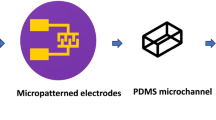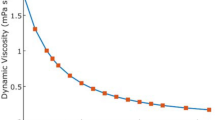Abstract
A new microfluidic-based approach to measuring liquid thermal conductivity is developed to address the requirement in many practical applications for measurements using small (microlitre) sample size and integration into a compact device. The approach also gives the possibility of high-throughput testing. A resistance heater and temperature sensor are incorporated into a glass microfluidic chip to allow transmission and detection of a planar thermal wave crossing a thin layer of the sample. The device is designed so that heat transfer is locally one-dimensional during a short initial time period. This allows the detected temperature transient to be separated into two distinct components: a short-time, purely one-dimensional part from which sample thermal conductivity can be determined and a remaining long-time part containing the effects of three-dimensionality and of the finite size of surrounding thermal reservoirs. Identification of the one-dimensional component yields a steady temperature difference from which sample thermal conductivity can be determined. Calibration is required to give correct representation of changing heater resistance, system layer thicknesses and solid material thermal conductivities with temperature. In this preliminary study, methanol/water mixtures are measured at atmospheric pressure over the temperature range 30–50°C. The results show that the device has produced a measurement accuracy of within 2.5% over the range of thermal conductivity and temperature of the tests. A relation between measurement uncertainty and the geometric and thermal properties of the system is derived and this is used to identify ways that error could be further reduced.







Similar content being viewed by others
Notes
Equation 6 uses a time shift, t 0, in place of actual short-time exponential terms to represent the delay in the arrival of the thermal wave to the sensor position. It is interesting to note that the alternative fitting function using just a single additional short time exponential mode: \( T(t)-T_{0}=\Updelta T_{1}\left({1-e^{{-t}/{\tau_{1}}}}\right)-{\Updelta}T_{2}\left({1-e^{{-t}/{\tau_{2}}}}\right)+\gamma t \) gives an equally good fit to the data. This could be used in place of Eq. 6 with the steady-state temperature rise given by ΔT = ΔT 1 − ΔT 2.
References
Asher GB, Sloan ED, Graboski MS (1986) A computer-controlled transient needle-probe thermal conductivity instrument for liquids. Int J Thermophys 7(2):285–294
Assael MJ, Charitidou E, Wakeham WA (1989) Absolute measurements of the thermal conductivity of mixtures of alcohols with water. Int J Thermophys 10(4):793–803
Berg PW, McGregor JL (1966) Elementary partial differential equations. Holden-Day, San Francisco
Bruce RH, Cannell DS (1976) Accurate method for the simultaneous determination of the thermal conductivity and specific heat of nonconducting solids. Rev Sci Instrum 47(12):1323–1330
Cahill DG (1990) Thermal conductivity measurement from 30 to 750 K: the 3ω method. Rev Sci Instrum 61(2):802–808
Carslaw HS, Jaeger JC (1959) Conduction of heat in solids, 2nd edn. Oxford University Press, Oxford
Cheng Y-T, Chang C-W, Chung Y-R, Chien J-H, Kuo J-S, Chen W-T, Chen P-H (2006) A novel CMOS sensor for measuring thermal diffusivity of liquids. Sens Actuators A 135:451–457
Choi SR, Kim D (2008) Real-time thermal characterization of 12 nl fluid samples in a microchannel. Rev Sci Instrum 79:064901, 1−5
De Groot JJ, Kestin J, Sookiazian H (1974) Instrument to measure the thermal conductivity of gases. Physica 75:454–482
Doebelin EO (1975) Measurement systems, application and design, revised edition. McGraw-Hill, New York
Filippov LP (1966) Methods of simultaneous measurement of heat conductivity, heat capacity and thermal diffusivity of solid and liquid metals at high temperatures. Int J Heat Mass Transf 9:681–691
Gustafsson SE (1991) Transient plane source technique for thermal conductivity and thermal diffusivity measurements of solid materials. Rev Sci Instrum 62(3):797–804
Gustafsson SE, Karawacki E, Khan MN (1979) Transient hot-strip method for simultaneously measuring thermal conductivity and thermal diffusivity of solids and fluids. J Phys D 12:1412–1421
Gustavsson M, Gustafsson SE (2006) Thermal conductivity as an indicator of fat content in milk. Thermochim Acta 442:1–5
Gustavsson M, Nagai H, Okutani T (2003) Thermal effusivity measurements of insulating liquids using microsized hot strip probes. Rev Sci Instrum 74(10):4542–4548
Hammerschmidt U (2003) A quasi-steady state technique to measure the thermal conductivity. Int J Thermophys 24(5):1291–1312
Hammerschmidt U, Meier V (2006) New hot-bridge sensor to measure thermal conductivity, thermal diffusivity, and volumetric specific heat. Int J Thermophys 27(3):840–865
Hooper FC, Lepper FR (1950) Transient heat flow apparatus for the determination of thermal conductivities. Trans ASHVE 56:309–324
Kuntner J, Kohl F, Jakoby B (2006) Simultaneous thermal conductivity and diffusivity sensing in liquids using a micromachined device. Sens Actuators A 130–131:62–67
Lide DR (ed) (2005) CRC handbook of chemistry and physics, 86th edn. Taylor and Francis, Boca Raton
MacInnes JM, Du X, Allen RWK (2003) Prediction of electrokinetic and pressure flow in a microchannel T-junction. Phys Fluids 15(7):1992–2005
Nix GH, Lowery GW, Vachon RI, Tanger GE (1967) Direct determination of thermal diffusivity and conductivity with a refined line-source technique. In: Heller GG (ed) Progress in astronautics and aeronautics. Academic Press, New York, pp 865–877
Van der Held EFM, Van Drunen FG (1949) A method of measuring the thermal conductivity of liquids. Physica 15(10):865–881
Van der Held EFM, Hardebol J, Kalshoven J (1953) On the measurement of the thermal conductivity of liquids by a non-stationary method. Physica 14:208–216
Voudouris N, Hayakawa K (1994) Simultaneous determination of thermal conductivity and diffusivity of foods using a point heat source probe: a theoretical analysis. Food Sci Technol 27:522–532
Wang CY, Yang ML (1995) A new calorimeter for measuring rapidly the thermal conductivity of liquids. Thermochim Acta 255:365–370
Xie H, Gu H, Fujii M, Zhang X (2006) Short hot wire technique for measuring thermal conductivity and thermal diffusivity of various materials. Meas Sci Technol 17:208–214
Zhang H, He L, Cheng S, Zhai Z, Gao D (2003) A dual-thermistor probe for absolute measurement of thermal diffusivity and thermal conductivity by the heat pulse method. Meas Sci Technol 14:1396–1401
Zhang H, Zhao G, Ye H, Ge X, Cheng S (2005) An improved hot probe for measuring thermal conductivity of liquids. Meas Sci Technol 16:1430–1435
Author information
Authors and Affiliations
Corresponding author
Rights and permissions
About this article
Cite this article
Kuvshinov, D., Bown, M.R., MacInnes, J.M. et al. Thermal conductivity measurement of liquids in a microfluidic device. Microfluid Nanofluid 10, 123–132 (2011). https://doi.org/10.1007/s10404-010-0652-x
Received:
Accepted:
Published:
Issue Date:
DOI: https://doi.org/10.1007/s10404-010-0652-x




